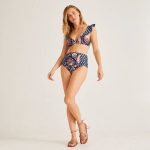The Swiss sporting goods provider On Holding AG has set itself ambitious growth targets for the next few years. In order to achieve this, expansion in markets such as China and the USA should also be promoted.
Speaking to FashionUnited, Marc Maurer reveals exactly what the sporting goods retailer’s current expansion plans look like and which retail partners it relies on in its wholesale strategy. On’s co-CEO also explains the company’s efforts in the area of circular economy and the brand’s cooperation with para-athletes so that they can achieve their best performance.
What is your current wholesale strategy?
It is important for us to be able to reach our groups of customers with the right products. We are working with innovations in running shoes, apparel and accessories for high performance sports, outdoor, movement and tennis. Apparel plays a very important role for us. We try to work with the right channels that allow us to reach our customers.
There are the running specialists, the outdoor retailers, but also general sporting goods such as SportScheck and department stores like Breuninger in Germany. We try to work with premium partners who fit our brand strategy. In addition, of course, we have our own distribution – our e-commerce and our own flagship stores – which are growing faster than wholesale. Together, this allows us to target our customers through the right channels.
Where do you want to reach your customers with your own physical store in the future?
We now have the first successful ‘test cases’ with our own flagships in New York, London and Zürich, which we will continue to expand. On the one hand in China, which is a market that relies very heavily on its own stores, but then also in western markets in Europe and the USA.
Are there any current opening plans in this regard?
In November, for example, we will be opening a further flagship store in London Spitalfields. In the new year, we will expand with more flagship stores, especially because it will allow us to better present our premium clothing to our customers and to make it a tangible experience.
Why is it so important for clothing in particular to be presented in the store?
For clothing in particular, a good three-dimensional presence is extremely important. Footwear is easier because shoes can be presented well on a wall and many partners have the expertise to bring them to the customer. With clothing, it is essential to work with good shop-in-shops to convey the added value of the products to the customers.
This works very well with partners with which we can build an installation directly in the shop. SportScheck is a good example, where we have a lot of our own space. This is even easier in our own stores, where we have a clothing share of up to 20 percent. That is more than twice as high as in classic wholesale.
In which markets do you want to grow even more?
In markets like the US or even England, we are currently growing very strongly, but there is still a lot of potential because the markets are very large. In markets like France, Italy, Scandinavia, Spain, Eastern Europe and China, we are still very small compared to the market potential. There, it’s about how we can build the brand through distribution expansion and brand awareness. This includes increased collaboration with our athletes and brand campaigns.
We are currently active in more than 50 countries and apart from Switzerland and Austria, we have no country where we even come close to maximum market penetration or saturation.
So the potential is exhausted in Austria and Switzerland?
In Germany, Austria and Switzerland we started and have been present since 2010. Here, we have a relatively high market penetration and are analysing how we can grow even further in new segments.
You work with various athletes and also individual federations. What role does sponsorship play for On besides its form as an outfitter?
We always come from the sport and how we interpret it. With tennis, for example, it’s a huge market that has seen very little innovation – footwear as well as apparel – but has very big potential to impact the lifestyle space in the coming months and years. It is also a market that allows us to work with athletes who identify strongly with On and share our brand values. We are incredibly happy to be working with Ben Shelton and Iga Świątek (ed.: tennis professionals).
How do you want to link sport with lifestyle?
We try to create events where we can connect with the community. This is extremely important, especially for a spectator sport like tennis, where there is little exchange between the community and the players. We have now implemented this in New York, where we rented tennis courts for a whole day in Brooklyn and brought the athletes together with the local community to play tennis.
In running, one of the things we have is On Track Nights, which is a track and field event with a festival feel, where we can bring the athletes close to the fans. In this way, we can have much more cultural impact and connect a wide variety of people. When we sponsor existing events, we have much less of that.
Para-athletes are also part of the On team. How does On deal with the individual needs of athletes with a handicap?
A good example is Zachary Friedley, who ran the Ultra-Trail du Mont-Blanc (ed.: ultramarathon, trail running around the Mont Blanc mountain group) with a flexible prosthetic leg. For his trail marathon he needed a special outsole with grip. During the tests, the sole quickly broke down because he has a completely different running style than ‘classic runners’. That’s why we work very closely with the athletes and try to find individual solutions.
We also have the ‘Right to Run’ project, a social programme that currently supports 19 organisations around the world that protect their communities’ fundamental right to run and exercise and help people access exercise.
Speaking of product development, what new products and technologies can we expect to see?
There is a lot to look forward to, especially with regards to the Olympics. We are currently testing new spikes with our athletes. There are also a lot of products coming onto the market in the clothing sector, where we are working with a lot of sustainable materials.
In addition to the Cloudneo, a fully circular running shoe that is part of the first subscription system for performance running shoes and apparel called ‘Cyclon’ we are working on another project: CleanCloud. Here, carbon emissions are used as the primary raw material for shoe soles. We want to show the sports industry and consumers that performance and sustainable materials go hand in hand.
How has the Cyclon subscription programme been received so far?
Cyclon was our test to scale sustainable products. We found that three groups of consumers were interested in the product – the early adopters (from a sustainability perspective), the runners, and the On fans who want to show their loyalty via the subscription system.
It is a long-term project where we also need the support of the consumer to change consumption behaviour and increase the willingness for a circular economy. With higher demand, we can lower prices and ensure the circularity of products. But we also need to increase the willingness of consumers to pay a little bit more for a more sustainable product.
Is the return of products to get a new one after they’ve worn not an obstacle for customers?
We see in our data that a lot of Cloudneo shoes come back. It also works in the timeline that we set – after about nine months, the shoes come back if the customer goes running about twice a week. There are many Cyclon customers who are willing to support the circular economy and return their worn-out shoes. We have a good renewal rate. But there are also some who try it once and then go back to something else. That’s why we want to offer a wider range of products and systems. Only one product will not work in the long run.
So the range of the programme will be expanded?
More products will come, which will also bring more variability. The current Cloudneo running shoe is very light and not very cushioned. The Cloudmonster offers more cushioning. We are a sportswear brand and offer head-to-toe apparel, so we are trying to add more products to the Cyclon range, besides the Cloudneo and Cyclon-T.
In addition, we are looking at other opportunities for a circular economy outside of a subscription system. With PET bottles, there is no need for a subscription model to return the bottles because there is an established network of collection points. The sports industry must also develop in this direction, so that it becomes the norm that clothing and shoes are returned after they have been worn out. We have the technical capabilities and infrastructure to recycle these products. This is something we are working on more intensively with our partners at the moment.
In conclusion, what are your expectations for the remainder of the current financial year?
The third quarter is going very well, we are looking very positively to the fourth quarter and actually in a relatively difficult environment. If you look at retail and consumer demand, the market has probably seen better times, but we are fortunately feeling relatively little of that. That makes us very positive for next year.
This article was originally published on FashionUnited.DE. Translating and edit by: Rachel Douglass.



